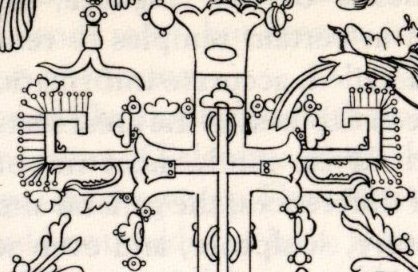2. By the way, when Metoro said rakau at a number of glyphs in our example text it perhaps was meant to indicate the beginning of the season of Waning Moon (and by force of the system of correspondences also the beginning of the season when Sun is descending), because on Hawaii 'high tide' came with the first night of the tree (Rakau-tu-tahi):
The words of Metoro should be considered together with the words of those who composed Manuscript E. The 'needles' and 'balls' in the 'tree glyphs' at the beginning of line Eb7 are probably somehow related to the same type of sign on the 'extensions' to the horizontal bar in the tree cross:  These curious extensions end with 'curves', somewhat similar to the shape a bodybuilder presents when he shows his biceps by holding arms outstretched with the joints of elbow, wrist, and hand forming sections of perpendicular 'limbs' decreasing in size. I guess rima means both this type of 'limb' and 5 (which number in turn associates to 'fire'). The little 'balls' are connected by 'needles' to the extended 'athletic arms' and maybe they represent stars visible from the horizontal part of the tree (possibly meaning the flat earth we are living on). Where the direction of the 'arms' abruptly changes upwards it could indicate that part of the sky dome which is close to the horizon. I had reason to once again discuss these matters because we should compare with the change of direction at Hanga Takaure, when the kuhane abruptly turned to the left in order to go from there across Poike. The 'Bay of Flies' evidently corresponds to a 'joint' in timespace, a place where the direction is changed. Later on it is said that she 'moved along a curve': The dream soul came to Rangi Meamea and looked around searchingly. The dream soul spoke: 'Here at last is level land where the king can live.' She named the place 'Rangi Meamea A Hau Maka O Hiva'. The mountain she named 'Peke Tau O Hiti A Hau Maka O Hiva'. The dream soul moved along a curve from Peke Tau O Hiti to the mountain Hau Epa, which she named 'Maunga Hau Epa A Hau Maka O Hiva'. The curve sign is used in the glyph type haś. The 'feather' marks around the curved outer form in haś are not straight as needles, and maybe these types of signs ('needles' and haś) are complementary. ... The 'bent branch' in a haś type of glyph probably represents the path of a luminary, beginning at bottom and moving up and clockwise, ending at the tip. The 'feathers' are used to indicate calendrical periods, great 'feathers' represent great periods and the smaller ones lesser periods. ... In the rongorongo system the light from fire is illustrated by 'feathers', while the light on the back side, the world of water, evidently is illustrated by 'bubbles':
|